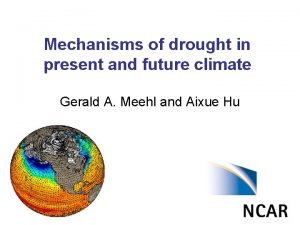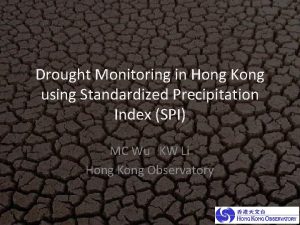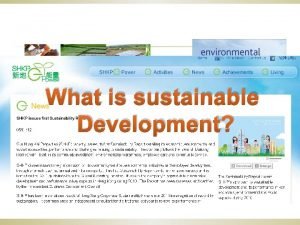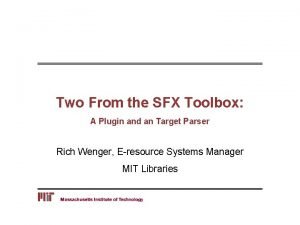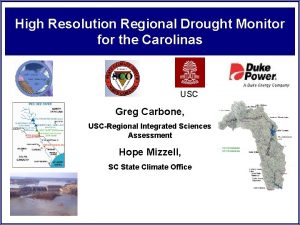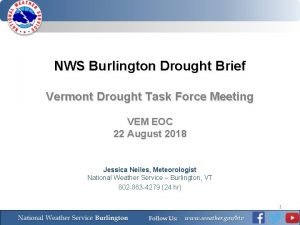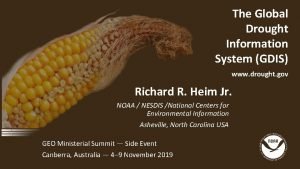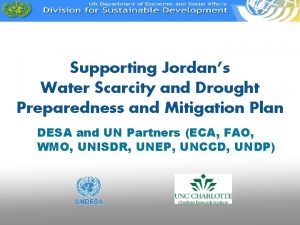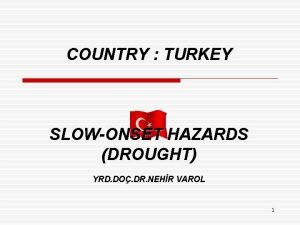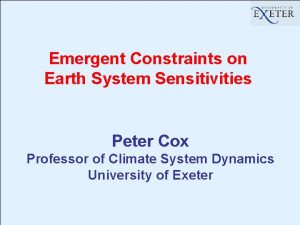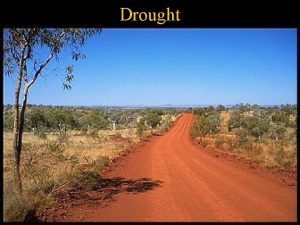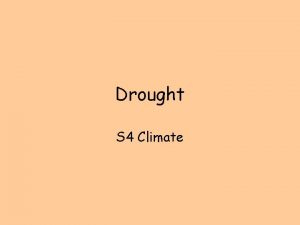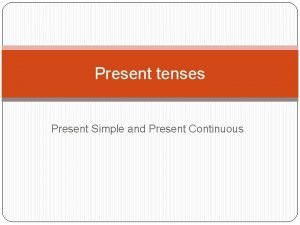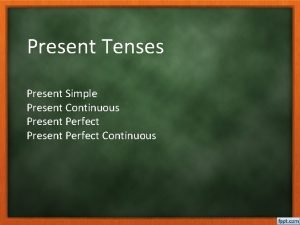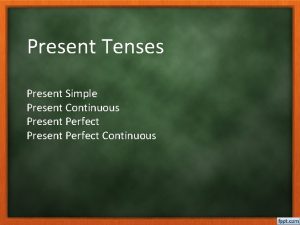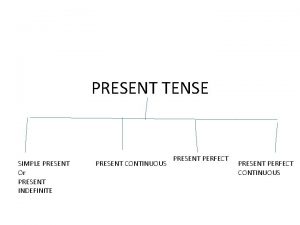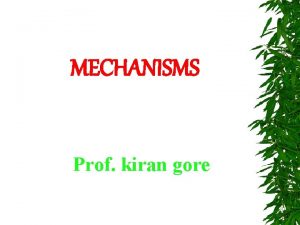Mechanisms of drought in present and future climate






























- Slides: 30

Mechanisms of drought in present and future climate Gerald A. Meehl and Aixue Hu

Definition of drought (premise: if it’s not raining it will be dry; must be simple to apply to model analysis) “Megadrought” (long-lived multi-decadal extreme drought often mentioned in a paleoclimate context): 11 year running mean area-averaged precipitation anomalies over western U. S. less than zero for at least 20 consecutive years (Meehl and Hu, J. Climate, 2006) (one megadrought every 170 years in a 1360 year global coupled climate model control run, or 0. 6 megadroughts per century) Is there an analogous simple definition for notorious shorter-lived decadal droughts that have had severe impacts in the U. S. (e. g. the 1930 s and 1950 s) for Great Plains and western U. S. areas?

Severe decadal drought definition based on historical precedents (1930 s and 1950 s droughts): negative values of 11 year running mean area-averaged precipitation that exceed one standard deviation for at least 5 consecutive years (rate of 2 per century) 1930 s 1950 s

In another 150 year long dataset, the 1880 s drought also qualifies (occurrence rate remains at 2 droughts per century) 1880 s 1930 s 1950 s

Correlations of (11 year running mean) observed western U. S. and Great Plains precipitation with observed SSTs confirms connections to tropical Pacific and Atlantic

Observed decadal pattern (1871 -2000), “IPO”, >13 yr low pass Pacific pattern strongly resembles the “Interdecadal Pacific Oscillation” (IPO, Power et al. , 1999)

IPO correlated with observed low pass precip, 1901 -2000

Multi-decadal IPO pattern from long model control run EOF 1 of low pass filtered (13 yr) SST ENSO EOF 1 of band pass filtered (2 -7 yr) SST

Correlation of IPO (multidecadal EOF 1 SST) with: Precipitation Sea level pressure (over North America, connected to convective heating anomalies in Pacific)

To look at future changes in decadal droughts: analyze stabilized forcing multi-hundred year global coupled climate model simulations (PCM and CCSM 3) “present-day”: 1990 control (300 years) “future”: 2100 -2300 from stabilized (at year 2100) A 1 B scenario (200 years) Severe drought: 11 year running mean precipitation anomalies exceeding 1 σ for at least 5 consecutive years Extreme drought: precipitation anomalies exceeding 2 σ for at least one year during a severe drought, or severe drought conditions for at least 10 consecutive years

Great Plains area (wrt respective climatology; 1 σ = 0. 05 -0. 07): PCM Present: 2 droughts per century; average duration 7. 8 years; extreme: 0. 7 per century (obs: 2/century, 9. 0 yrs, 1. 0/century) Future: 0. 5 droughts per century; average duration 9. 0 years; extreme: 0. 5 per century CCSM 3 present: 1. 1 droughts per century; average duration 11. 0 yrs; extreme: 0. 9 per century Future: 0. 5 droughts per century; average duration 9. 0 years; extreme: 0 per century

Western U. S. area (wrt respective climatology; 1 σ = 0. 05 -0. 06): PCM Present (350 yrs): 2 droughts per century; average duration 7. 0 yrs extreme: 1. 0 per century (obs: 2/century, 9. 5 yrs, 0. 5/century) Future (200 yrs): 2 droughts per century; average duration 5. 3 years; extreme: 1. 0 per century CCSM 3 present (300 yrs): 2. 0 droughts per century; average duration 8. 0 yrs; extreme: 0. 6 per century Future (200 yrs): 0. 5 droughts per century; average duration 8. 0 years; extreme: 0. 5 per century

Great Plains precipitation correlated with SSTs (11 yr running means) dominant connection with tropical Pacific (cold tropical Pacific = dry Great Plains); Future pattern somewhat weakened compared to present, but qualitatively similar present-day CCSM 3 PCM future

Western U. S. precipitation correlated with SSTs (11 yr running means) dominant connection with tropical Pacific (cold tropical Pacific = dry Western U. S. ); Future pattern somewhat weakened compared to present, but qualitatively similar CCSM 3 PCM

There are significant contributions of multi-decadal Pacific SST anomalies (IPO/PDO) to severe drought over both the Western U. S. and Great Plains Therefore, understanding the mechanism of severe drought over North America requires (at least) understanding the mechanism of the IPO/PDO that produces the multidecadal SST anomalies

______ Mechanism for multi-decadal SST and precipitation variability in the Indo-Pacific region (Meehl, G. A. , and A. Hu, 2006, Journal of Climate, 19, 1605– 1623. )


CMIP 3 multi-model future changes of season-averaged precipitation show large seasonal changes in the pattern over North America (dry in far southwest U. S. and Mexico during winter; dry over the Pacific northwest and southern Great Plains in summer) Fig. SPM-6 Stippled areas are where more than 90% of the models agree in the sign of the change Precipitation increases very likely in high latitudes Decreases likely in most subtropical land regions This continues the observed patterns in recent trends

Average future JJA surface temperature change shows relatively greater warming in western U. S. due to changes in circulation (more ridging over western U. S. ) associated with convective heating anomalies in tropical Pacific

Proportionately greater increases of western U. S. temperature (and decreased precipitation) increase vulnerability to future drought in terms of precipitation and evaporation (P minus E becomes more negative there in future)

Western U. S. P minus E mean base state climate change for JJA PCM: -0. 21 mm day-1 CCSM 3: -0. 08 mm day-1 1 σ for both about 0. 01 to 0. 02 mm day-1 JJA base state change roughly an order of magnitude greater than one standard deviation, so virtually every year in future climate would be a severe drought year by present-day standards

Great Plains P minus E mean base state climate change for JJA PCM: -0. 12 mm day-1 CCSM 3: -0. 02 mm day-1 1 σ for both about 0. 04 to 0. 06 mm day-1 JJA base state change produces a tripling of severe drought in PCM, and a doubling of severe drought in CCSM 3

Conclusions 1. Severe droughts over two areas of North America (western US and Great Plains) defined in relation to historical severe droughts of 1930 s and 1950 s in terms of multi-decadal precipitation anomalies 2. Similar patterns of SSTs that drive present-day droughts (relative cool tropical Pacific SSTs) also drive future droughts; a warmer base state appears to qualitatively reduce drought severity somewhat with respect to the new future climate 3. A mechanism proposed to explain the decadal pattern of SSTs in the tropical Pacific associated with droughts over North America involves coupled interactions between tropics-midlatitudes and ocean-atmosphere with wind-forced ocean Rossby waves near 25 N and 25 S providing the decadal timescale 4. In relation to present-day droughts, future summertime droughts more severe due to warmer mean temperatures and enhanced evaporation (P minus E becomes more negative) 5. In western U. S. every year is a severe drought year in future compared to present drought regime; over Great Plains there is a doubling to tripling of severe droughts in future compared to present


Can we predict North American droughts 10 to 30 years in advance? “Decadal prediction” regional skill could come from three sources: 1. Climate change commitment from the forcing already in the system 2. Climate change from the forcing from ongoing increases of GHGs 3. Predicting time-evolving regional decadal phenomena whose mechanisms could be captured in an initialized climate state (e. g. PDO/IPO, MOC, AMO, etc. )

An example: EOF 1 from a model 20 th century simulation is the forced trend Let’s see if we can predict EOF 2 (the internally generated IPO pattern associated with North American drought) in a perfect model ensemble experiment

Decadal predictions of IPO index for the Pacific 9 out of 29 members (31%) show some predictive skill out to 20 years (CCSM 3. 0, T 42, atmospheric initial state perturbed with same ocean initial state at year 2000; one reference, 29 ensemble members)


CMIP 5 Decadal Predictability/Prediction core model runs: 1. 1 10 year integrations with initial dates towards the end of 1960, 1965, 1970, 1975, 1980, 1985, 1990, 1995 and 2000 and 2005 • Ensemble size of 3, optionally to be increased to O(10) • Ocean initial conditions should be in some way representative of the observed anomalies or full fields for the start date • Land, sea-ice and atmosphere initial conditions left to the discretion of each group • Model run time: 300 years (optionally, an additional 700 years) 1. 2 Extend integrations with initial dates near the end of 1960, 1980 and 2005 to 30 yrs. • Each start date to use a 3 member ensemble, optionally to be increased to O(10) • Ocean initial conditions represent the observed anomalies or full fields. • Model run time: 180 years (optionally, an additional 420 years)

 Drought present tense
Drought present tense Future perfect continuous example
Future perfect continuous example Future perfect future continuous future perfect continuous
Future perfect future continuous future perfect continuous Drought and desertification
Drought and desertification Climate change 2014 mitigation of climate change
Climate change 2014 mitigation of climate change Sentence for drought
Sentence for drought Hong kong drought
Hong kong drought Concept of sustainable development
Concept of sustainable development Drought usaco
Drought usaco Drought presentation
Drought presentation Anasazi drought
Anasazi drought Mrsac maharashtra gov in jalyukt
Mrsac maharashtra gov in jalyukt Vermont drought monitor
Vermont drought monitor Utah drought map
Utah drought map Drought stopper system
Drought stopper system World, drought monitor
World, drought monitor Jordan drought
Jordan drought What are solutions of drought
What are solutions of drought Present continous
Present continous Present past future simple exercises
Present past future simple exercises Past simple future
Past simple future Future simple in the past
Future simple in the past Present perfect continuous passive voice exercises
Present perfect continuous passive voice exercises Passive with present continuous
Passive with present continuous Simple past simple present will future
Simple past simple present will future Passive of present continuous present perfect future
Passive of present continuous present perfect future Progressing emergent constraints on future climate change
Progressing emergent constraints on future climate change Present simple present continuous and present perfect
Present simple present continuous and present perfect Future continuous.
Future continuous. Tense chart
Tense chart Future plans and finished future actions
Future plans and finished future actions
